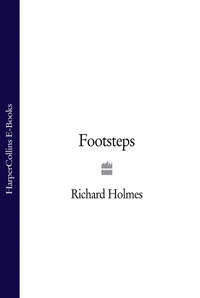
Полная версия
Footsteps
I knew little of Fanny Vandergrift Osbourne at the time I followed Stevenson through the Gévaudan. The story of their tempestuous but largely successful marriage—which took them through California, back to Edinburgh, down to Hyères, and finally out again to America, the South Seas, Tahiti and Samoa, with Stevenson all the time writing, his professional path found, Treasure Island (1883), Dr Jekyll and Mr Hyde (1886), The Master of Ballantrae (1889) and the posthumous Weir of Hermiston (1889)—belongs to the mature part of his biography. But what I subsequently learned of Fanny’s early life, and her personality, confirmed a great deal of what I was already seeing in Stevenson’s own nature at this time—his needs, his strengths, his weaknesses. The difficulties of their early love affair also showed me more clearly the hidden significance of his pilgrimage through the Cévennes: a preparation for his journey of emigration the following year to San Francisco—also undertaken alone—to claim his bride.
Fanny Vandergrift broke the rules, almost all of them, and that was her first and enduring charm. She was a spirit quite as original and adventurous as Stevenson. Born in Indianapolis, Indiana, in March 1840, she was thirty-six when she first met him at Grez in 1876. Her ancestors were Dutch and Swedish; her parents were pioneer farmers who let her run wild on a series of small ranches. They had her baptised in the Presbyterian faith—an interesting emotional link with Stevenson—in one of the total immersion ceremonies in the White River when she was two. By her teens she had grown up into a strong, dark-haired, gypsy-looking girl, who could ride, use a rifle, grow vegetables, make wine, and hand-roll cigarettes. Her passion was painting, and because she was not thought a belle her style was that of the tomboy artist, dashing and devil-may-care. She had big, dark eyes, a determined jaw, and a powerful, stocky body with great sexual presence that remained with her late into middle-age. “God made me ugly,” she used to say with sultry good humour, and the result was that everyone thought her a handsome gal of spirit. She was popular, and her sister Nellie recalled that “there was scarcely a tree in the place that did not bear somewhere the name or initials of Fanny Vandergrift”.
She was married at seventeen—probably already pregnant—to a young lieutenant on the Governor’s staff, Sam Osbourne. He was blond, six-foot, quixotic, amiable and incurably unfaithful, and she loved him passionately. They went West to seek their fortunes, living in mining towns in Nevada, and when the gold-boom was over settling in San Francisco, in 1866. Sam was frequently away, fighting Indians with the army, prospecting in Montana with friends, or having affairs with saloon ladies. But he was always back when the children were born: Isabel (“Belle”) in 1858; Lloyd in 1868; and Hervey in 1871. Jealous rows and passionate reconciliations became the pattern of the household, but gradually Fanny emerged as the stronger, more capable and more stable figure: her children were devoted to her, and remained emotionally dependent on her for the rest of their lives. Moreover Fanny, far from becoming embittered and frumpish, seemed almost to grow younger and more carefree as her family grew up. She lost none of her dash, good humour or energy; she always seemed game for anything. During the 1870s strangers often mistook her and Belle for sisters. When Belle was sent to finish her education at the San Francisco School of Design, Fanny enrolled too as a mature student, and a whole new circle of friendships opened out for her among the artistic “European” set in the city. In particular Fanny became friendly with a young Irish-American lawyer, Timothy Rearden, who was Head of the Mercantile Library, and knew writers like Bret Harte. Rearden became her mentor, possibly for a time her lover. He encouraged her to paint and write, read French and German, think about a new life—a second chance.
Fanny seized the opportunity in a way that would have been almost impossible for her contemporaries in Victorian England or Second Empire France. In 1875, when Belle was seventeen, Lloyd seven and Hervey four, she set off with her three children to study art in Antwerp. Sam Osbourne stayed behind in San Francisco, promising to pay a small allowance. Fanny was at last une femme indépendante, a triumph of spirit over circumstance. A photograph of her at this time shows a distinctly romantic heroine: a dark, determined woman apparently in her late twenties (she was actually thirty-five) with a mass of wild hair brushed impatiently back behind her ears. She wears a velvet-edged jacket over a tight-fitting black dress that carelessly shows off her figure. Knotted round her throat is a large white neckerchief, tied like a man’s tie, loose and full, faintly provocative. The eyes are large and frank, the mouth strong and beautifully formed. She combined force of character with a certain indefinable vulnerability. Her daughter Belle recalled that on the steamer from New York “when in any difficulty, she only had to look helpless and bewildered, and gallant strangers leaped to her assistance”.
Life was not easy in Antwerp. Money was scarce, the lodgings poor, and worst of all the Antwerp Academy would not accept women students. The American Consul tried to help her and Belle find private tuition, but then little Hervey fell ill with fever, and they were advised to take the child to a specialist in Paris. By December they were living in rooms in Montmartre, but in the spring of 1876 Hervey was still ailing, and Lloyd had vivid memories of hanging about hungrily outside patisserie windows because all their money was spent on doctors’ bills. Fanny sent a telegram to Sam Osbourne in San Francisco, telling him their son was dangerously ill. He arrived in Paris to be at Hervey’s death-bed. Bemused with grief, Fanny went back to her life-classes at the atelier, but had fainting fits and hallucinations, and trembled on the edge of a nervous breakdown.
Their French doctor strongly advised them to take Lloyd out of Paris to spend the summer in the country. Fanny discussed this with her friends at the atelier, and a young American sculptor told them about the Hotel Chevillon at Grez-sur-Loing. Sam agreed to come with them, at least for a time; they put their belongings in store and climbed aboard a train.
It was too early in the summer for many others to be in residence, and the hotel was quiet and friendly. Lloyd began to eat and run about like a young colt; Fanny and Belle sat peacefully painting riverscapes and walking in the water-meadows; Sam drank and chatted with Will Low. Gradually other painters turned up at the phalanstére, and each accepted the Osbournes as a picturesque addition to the bohemian enclave. Frank O’Meara fell in love with Belle, and there was much talk of what would happen when the mad Stevensons, Bob and Louis, finally arrived to complete the party. Days were spent swimming, lunching out under the trees, painting in the fields under white umbrellas.
First to arrive at Grez was Bob Stevenson, a tall erratic figure with Mexican moustaches and a ceaseless, brilliant flow of mocking talk. He was generally regarded as the “genius” of the two cousins: painter, musician, linguist, drinker and unreformed rake. He dazzled but also rather frightened Fanny; she described him as “exactly like one of Ouida’s heroes”.
Then, one evening in early July 1876, cousin Louis made his appearance. Young Lloyd Osbourne, who was soon to hero-worship him, remembered the scene vividly. It was dinner-time, with some fifteen of the phalanstére sitting round the long wooden table in the main room of the Chevillon. Oil-lamps stood along the board, pitchers of wine circulated, laughter flew back and forth. The main windows of the dining-room stood open to let in the sweet night air. Occasionally moths flew in from the darkness and fluttered against the bright glass chimneys of the lamps. Fanny and Belle were the only women in the company, and all attention was on them. Then little Lloyd heard a faint noise outside the window, and saw a shadow moving and hesitating beyond the light. There was a clatter of boots, a thin brown forearm on the window-sill, a sharp exclamation, and a dusty figure wearing a slouch hat and carrying a knapsack vaulted lightly into the room. Bob rose gravely from his chair and, turning to the Osbournes, announced like a conjuror: “My cousin, Mr Louis Stevenson.” It was a grand entrance, never to be forgotten, and often to be embroidered. Stevenson himself later said he had waited many minutes outside in the dark, gazing into the bright room, transfixed by Fanny’s face, acknowledging his destiny. Perhaps he did. Certainly Sam Osbourne left Grez and returned to America in September; and when Fanny returned with Belle and Lloyd for the winter to her lodgings at 5 rue Douay in Montmartre, Stevenson soon moved to rooms nearby. As Lloyd put it with delight, “Luly is coming.”
Yet the affair took two years, with much coming and going between Paris and London and Grez, before it became really serious for both of them. Stevenson had other elder Muse figures on hand, notably Mrs Fanny Sitwell, the confidante and future wife of his friend Sidney Colvin. While Fanny Osbourne, for her part, was equally attracted by Bob Stevenson to begin with. Indeed, there is some reason to think that initially Bob was the favourite. She described them both, in a suitably colourful style, in a letter of April 1877 to Timothy Rearden, in San Francisco. It told me a good deal about the Stevenson family penchant for romancing about themselves, and playing incorrigible, boyish bohemians. She wrote:
Bob Stevenson is the most beautiful creature I ever saw in my life, and yet somehow, reminds me of you. He spent a large fortune at the rate of eight thousand pounds a year … studied music and did wonderful things as a musician, took holy orders to please his mother, quit in disgust, studied painting and did some fine work, and is now dying from the effects of dissipation and is considered a little mad. [In fact Bob soon married, had a family, and comfortably outlived Louis.]
Louis, his cousin, the hysterical fellow, is a tall gaunt Scotchman with a face like Raphael, and between over-education and dissipation has ruined his health, and is dying of consumption. Louis reformed his habits a couple of years ago, and Bob, this winter. Louis is the heir to an immense fortune which he will never live to inherit. His father and mother, cousins, are both threatened with insanity, and I am quite sure the son is.
Madness, sickness, lost fortunes and wasted genius: it all sounded like a delicious game to Fanny. Yet pretending that she will never meet them again (both cousins had returned home to Britain until the next summer), she added a warmer and truer note:
… The two mad Stevensons with all their suffering are men of spirits, but so filled with joyfulness of there living that their presence is exhilarating … I never heard one of them say a cynical thing, nor knew them to do an unkind thing. With all the wild stories I have heard of them fresh in my mind, I still consider them the truest gentlemen …
“Gentlemen” she uses in an American sense; not snobbishly, but virtuously—men of honour, manners, sincerity.
Fanny became serious about Louis Stevenson after the second summer at Grez. Bob went back to Edinburgh, but Louis returned with her again to Montmartre, and here he was really taken ill, not with consumption, but with a form of conjunctivitis which threatened to leave him blind. Fanny, suddenly thrown into the role of nurse and mother, took one of her headstrong decisions which even in Paris might have been considered socially foolhardy. She moved Stevenson into her own apartment, put him to bed and throughout October 1877 looked after him like one of her own family. When he grew no better she sent another of her telegrams to Sidney Colvin in London, and in November took Stevenson over on the boat-train. It was thus that she suddenly found herself introduced into Stevenson’s London literary circle—meeting Colvin himself, Henley, Gosse, and even his Muse Mrs Sitwell.
Fanny was now dealing with the realities, as well as the dreams, of Stevenson’s existence. She was his nurse as much as his mistress; though Stevenson himself hardly seems to have been aware of this subtle shift of emotional balance. What he saw was a beloved companion who had proved herself true and practical, and utterly regardless of conventions. What his friends saw—and they all liked her instantly—was summed up by Sidney Colvin:
Her personality was almost as vivid as his. She was small, dark-complexioned, eager, devoted; of squarish build—supple and elastic; her hands and feet were small and beautifully modelled, though busy; her head a crop of close-waving thick black hair. She had a build and character that somehow suggested Napoleon, with a firm setting of jaw and beautifully precise and delicate modelling of the nose and lips; her eyes were full of sex and mystery as they changed from fire or fun to gloom or tenderness.
In fact Fanny was rather formidable.
Stevenson recovered his health, if not his heart, and went back to Edinburgh for a parental Christmas, while Fanny returned to Paris. It was at this time that Stevenson finally spoke of the relationship to his father and mother, and it seems clear that he was now thinking of marriage. They were hardly pleased: an American woman ten years older than Louis, and moreover a married woman with two children to support. In January 1878 Stevenson went back to Paris, and in February his father Thomas Stevenson joined him there for a man-to-man talk. “Don’t be astonished,” Stevenson wrote to Sidney Colvin, “but admire my courage and Fanny’s. We wish to be right with the world as far as we can.” There is no evidence that his father actually met Fanny, but in the event the vital allowance of a hundred pounds a year was not cut off, as Stevenson had feared; and he seems to have reached a better understanding with his father about his free-thinking religious beliefs.
But what was going on in Stevenson’s mind? By far the most revealing document to me consisted of a linked series of four essays which he wrote for the Cornhill magazine and Henley’s London magazine between 1877 and 1879. He later collected them in 1881 under the general title of Virginibus Puerisque (“To Youths and Maidens”). The first two essays concern marriage and the marriage relationship; the third is headed “On Falling in Love”, with the Shakespearian epigraph—“What fools these mortals be!”; and the fourth is called, severely, “Truth of Intercourse”. But all four are evidently drawn from his passion for Fanny, and they represent an entirely new note in his work and outlook.
The tone Stevenson adopted was ironic, mildly facetious, even slightly misogynic. Considering the circumstances under which he was composing this surprised me very much. It runs right through all four essays, from the famous definition of marriage as “a sort of friendship recognised by the police” to the long peroration on the terrors of the righteous wife. “Times are changed with him who marries; there are no more by-path meadows, where you may innocently linger, but the road lies long and straight and dusty to the grave … To marry is to domesticate the Recording Angel. Once you are married, there is nothing left for you, not even suicide, but to be good.” What is one to make of all this?
Part of the answer seems to be that Stevenson, having really fallen in love with Fanny, was genuinely frightened—even terrified—by the implications. She was not the first woman he had flirted with, played bohemians with or slept with. But she was undoubtedly the first woman to become so important to him that she made his life incomplete, and challenged his identity. All the rapid shuttlings between England and France vividly suggest this, and everywhere the essays bear it out.
There is the frank avowal: “The fact is, we are much more afraid of life than our ancestors, and cannot find it in our hearts to marry or not to marry. Marriage is terrifying, but so is a cold and forlorn old age.” Or there is the mocking paradox: “Marriage is a step so grave and decisive that it attracts light-headed, variable men by its very awfulness.” There is even the rather knowing and hopeful: “It is to be noticed that those who have loved once or twice already are so much better educated to a woman’s hand; the bright boy of fiction is an odd and most uncomfortable mixture of shyness and coarseness, and needs a deal of civilising.”
Above all, there is Stevenson’s hymn to the eternally boyish in man, the Peter Panish element (though that is an anachronism), which he felt intuitively it was dangerous, even a crime, to deny. The true threat of marriage, as he saw it, came down finally to this: that it would kill the boy in him. This passage is one of the best in the Virginibus Puerisque, and evidently links with Stevenson’s meditations on those threats to “the dreams of boyhood, the schemes of youth” during his night at La Trappe. He is considering the “unfading boyishness of hope”, what he defines as the piratical quality, the refusal to be quite tamed or rational or responsible, Tom Sawyer’s “Ah, if he could only die temporarily. Turning aside for a moment from the imminent threat of marriage, he suddenly stops to wonder if boyishness is not, after all, an irreducible quality even in the most sage and settled of his fellow-citizens. The thought develops in a now characteristic way, in which a journey through a harsh landscape is already foreseen, even predicted:
Here we recognise the thought of our boyhood; and our boyhood ceased—well, when?—not, I think, at twenty; nor perhaps altogether at twenty-five; nor yet at thirty; and possibly, to be quite frank, we are still in the thick of that arcadian period. For as the race of man, after centuries of civilisation, still keeps some traits of their barbarian fathers, so man the individual is not altogether quit of youth, when he is already old and honoured, and Lord Chancellor of England. We advance in years somewhat in the manner of an invading army in a barren land; the age that we have reached, as the phrase goes, we but hold with an outpost, and still keep open our communications with the extreme rear and first beginnings of the march. There is our true base; that is not only the beginning, but the perennial spring of our faculties; and grandfather William can retire upon occasion into the green enchanted forest of his boyhood.
In a literary way, this idea is central not only to the kind of books Stevenson went on to write (with their mixture of boyish adventure and very adult nostalgia), but to a whole tradition of late Victorian and Edwardian fiction. J. M. Barrie, Kenneth Grahame and Rudyard Kipling are all foreseen. But I saw only the immediate and personal situation.
The spring of 1878 did not bring Stevenson anywhere nearer a practical decision about Fanny. Though he had published An Inland Voyage in May, and gone some way to establishing himself in his own eyes as a professional author, their shared future still seemed unassured. Stevenson returned to London to work as an assistant editor on Henley’s London magazine, and suddenly in July Fanny announced that she was returning to California. If it was an ultimatum Stevenson did not respond; but it is likely that Fanny—still married to Sam—was in just as much turmoil as he. Lloyd recalled with feeling: “I had not the slightest perception of the quandary my mother and RLS were in, nor what agonies of mind their approaching separation was bringing.”
The three Osbournes left on the boat-train from London in August, and Stevenson, pale and silent, came to see them off. He could not bear to wait till the train pulled out but, wrapping his long brown ulster coat round his thin shoulders, strode off down the platform without glancing back. In September he reached the Cévennes, and only then did he dare to look about him.
4
After La Trappe there seemed to be a new sense of determination about Stevenson’s route. He was rested, and certain issues must now have been clearly in the forefront of his mind. He and Modestine now embarked on the great upland peaks of the central Cévennes: the Montagne du Goulet at 4,700 feet; and, a day’s walk beyond it, the Pic de Finiels at 5,600 feet. It is a different landscape from the Gévaudan, bolder, wilder, more dramatically plotted. It is visionary highland country: steep woods of scented pine climb sharply upwards to windy expanse of bare moorland, heath, rolling grass or scree; then drop back down in precipitous alpine meadows, or rocky gorges, rushing streams and deep green-and-gold terraces of chestnut trees. You walk against the sky, with chain after chain of hills rolling southwards at your feet.
This is also the beginning of the “country of the Camisards”, the Protestant rebels of the regional insurrection of 1702-3, whose history had fascinated Stevenson from adolescence, when he sketched out The Pentland Rising about a similar upheaval in the eighteenth-century Scottish highlands.
The last eight chapters of the Travels are largely concerned with this Camisard history, together with Stevenson’s reflections on the nature of religious belief and bigotry. The effect of this in the published text is to give the last third of his journey a curiously impersonal feel, an essay in regional history, which is quite at odds with the almost confessional tone of the previous days. He retells the stories of the various Camisard commanders—“Spirit” Séguier, Roland and Joani—together with the atrocities performed by the Catholic generals like Maréchal Julien in suppressing the movement (despite promised English aid) on the orders of the French King. It is a saga not unlike that of twelfth-century Cathars, persecuted by the armed forces of the Inquisition, further south in the Basses-Pyrenees; and it shows the nascent historical novelist in Stevenson.
When he stands on the top of Mont Mars, after a long, lonely, exhausting climb, his reflections appear to be totally absorbed in the long-ago struggles of these French covenanters:
I was now on the separation of two vast watersheds; behind me all the streams were bound for the Garonne and the Western Ocean; before me, was the watershed of the Rhone. Hence, as from the Lozère, you may see in clear weather the shining of the Gulf of Lyons, and perhaps from here the soldiers of Salomon may have watched for the topsails of Sir Cloudesley Shovel, and the long-promised aid from England. You may take this ridge as lying in the heart of the country of the Camisards; four of the five legions camped all round it and almost within view—Salomon and Joani to the north, Roland and Castanet to the south—and when Julien had finished his famous work, the devastation of the High Cévennes, which lasted all through November and October, 1703, and during which four hundred and sixty villages were utterly subverted, a man standing on this eminence would have looked forth on a silent, smokeless, and dispeopled land.
It is a vivid picture; and standing on the same high, lost ridge myself, it was easy to imagine Stevenson’s gaze traversing the wild horizon, and conjuring up the shades of the lost Camisards: Spirit Séguier leaping to his death from the window of a surrounded house in Le Pont de Montvert, Roland fighting to the end with his back against an olive tree.
Yet such an image of Stevenson, immersed in historical reflections on his last days, struck me as false. In his original journal there is only one single glancing mention of the Camisards, while he is talking to a poacher—“a dark military-looking wayfarer, who carried a game-bag on a baldrick”—on the general theme of the local Protestantism. For the rest, the colourful accounts and anecdotes of Camisard history are much later additions to the text, worked up from Peyrat’s Pasteurs, the novels of Dinocourt and Fanny Reybaud, and half a dozen other sources, long after Stevenson’s return to England.
The visions of the Camisards in fact serve to cover up Stevenson’s completely different preoccupations at the time. The original journal becomes brief, disjointed, dreamlike and in places highly emotional. Though he travels with increasing speed and purpose he is sunk in his own thoughts, physically driving himself—and Modestine—towards the point of exhaustion.









